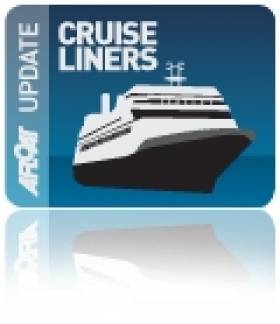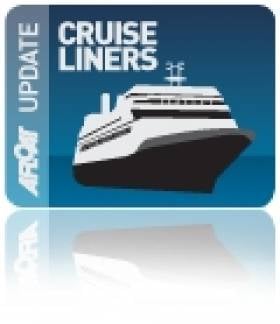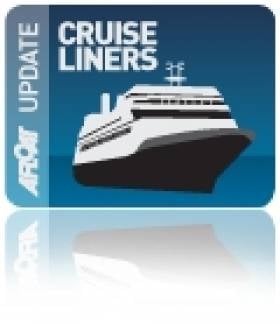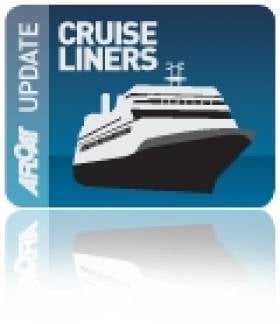Displaying items by tag: Azura
Not One Not Two but Three Cruise Callers to Cork
Next in terms of tonnage is Holland America Line's near 60,000 tonnes Rotterdam, for more about the 1997 built click this LINK. The final member of the trio belongs to Saga Cruises subsidiary Spirit of Adventure cruises, the 10,000 tonnes Spirit of Adventure. For a visual virtual tour of the vessels interior facilities click HERE.
Spirit of Adventure was scheduled in late April on a 14-day 'Relics of Rome' cruise which was to include ports of call to Libya, Tunisia and Egypt but this was cancelled due to the political situation throughout North Africa.
The combined cruise calls to Cork Harbour has a potential capacity of 5,200 passengers and the mid-July arrival confirms the ports popularity which is to welcome this year a total of 54 cruiseships and over 100,000 passengers. Azura and Spirit of Adventure are to share the berth at Ringaskiddy while the Rotterdam is to berth at the dedicated cruise terminal in Cobh.
Brand New Marina Calls to Dublin
The cruise started from Copenhagen and toured several ports in Norway from where the vessel continued to Lerwick, Torshavn,Iceland, Portree and her last port of call was Belfast. The vessel had berthed in Dublin's Alexandra Basin and departed this evening bound for Dover.
Following the Marina's departure out of Dublin Bay via the North Burford bouy, was the Marco Polo. The 1965 built vessel operates for Cruise and Maritime Voyages and she proceeded past the South Burford bouy bound for St. Mary's, the capital of the Scilly Isles.
There will be many more cruisecalls such as the ultra luxury six-star Silver Cloud which is due on Sunday. The 16,927 tonnes vessel operated by Italian owned SilverSeas Cruises, has only a capacity for 294 passengers. Following that visit P&O Cruises 115,000 tonnes Azura docks in the capital this day next week to disembark up to 3,500 passengers. To view a full list of cruise callers click HERE.
Azura Cruise Liner Docks in Cobh for the First Time
In another first for Cork Harbour the 115,000 ton Azura cruise liner docked in Cobh last Friday.
After her maiden voyage in April, Azura spent summer based in Southampton cruising to the Mediterranean, the Baltic and the Canary Islands. She'll be sailing the Caribbean in winter from Barbados.
She holds 3,100 passengers based on double occupancy (3,574 when all the berths are full).
At 290 metres long and 36 metres wide she looked an impressive sight on the Cobh quayside as our photos show below.
P&O Cruise's Azura is the company's latest cruise liner. Built at the Monfalcone shipyard in Italy, the Azura is one of P&O's largest ships, boasting 14 public decks, 11 restaurants, five boutiques, four pools, two lounges and over 900 private balconies. It also features an outdoor cinema, a first for the company, along with an al fresco spa and single staterooms.

Above and below: two views of the new Azura berthed in Cobh last Friday. Photo: Bob Bateman

The Big One: Azura Cruises into Dublin
As the cruise season draws to a close, the Azura, the largest cruise-ship (116,000 gross registered tonnes) to call at Dublin, docked this morning at the port for the third time this year, writes Jehan Ashmore.
A unique feature is the huge 20-metre plasma screen video wall mounted on an after bulkhead. In addition the venue is used to broadcast major sporting events. The Sea Screen outdoor cinema is the first of its kind in the P&O Cruises fleet as is the novelty of passengers having an option of
single stateroom accommodation.
Azura is one of 12 vessels eminating from the 'Grand' class vessels built for Miami based Carnival Cruise Corporation which includes P&O Cruises and Princess Cruises. The leadship, Grand Princess became the first of the class to call at Dublin in 2004 and also had the distinction as the first cruiseship to surpass the 100,000gt mark to dock at the port. Last month, another near-sister, Emerald Princess, measuring 113,000grt called to Dublin.
In total there will be 86 cruise ships visiting Dublin this year, marking another record-breaking season. The sector is expected to generate €35-€55m to the local economy from approximately 80,000 high-spending passengers.
The Azura departs Dublin tonight at 21.15hrs for Cork, where the giant vessel is to berth at the Cobh Cruise Terminal. There will be off-season cruise-calls to the capital next month by Ocean Countess and Norwegian Sun, arriving from Belfast on 2 October. The last cruise-caller to Dublin this year will
be Fred Olsen Cruises Boudicca with two visits in November.
Dublin and Cork Share Cruise-Calls Bonanza
The ports of Dublin and Cork are scheduled to receive a record 139 cruiseships in total this year, bringing 180,000 visitors and crew. Many more of these cruiseships are due to visit over the next two months and stretching into late Autumn. Between €35-55m is expected to be generated into the Dublin region from high-spend cruise visitors
while a further €5m is predicted for the local economy at Cork, writes Jehan Ashmore.
A notable visitor due to grace Dublin Bay is the return of The World, albeit not strictly a cruiseship but the first custom-built time-share ship. The vessel is to dock in the capital for four-nights from 4-8 August and then sails overnight to Cobh, for two-nights from 9-11 August.
In essence, The World presents an exclusively unique lifestyle experience. Instead of passengers, there are 'residents' who live onboard. Residents of the 43,188 gross tonnes (GT) vessel don't merely occupy a cabin but own large-sized luxurously appointed private apartments that are 'home' complete with balconies.
On 9 August, Silver Cloud docks at Dublin from Oban, Scotland. Measuring 16,927 GT, the vessel may not be the largest with only 315 passengers, but is an ultra-luxury cruiseship, regarded as one of the highest standards in the cruise-sector industry.
Returning to Cork Harbour, Cobh awaits the mighty Independence of the Seas. At 154,407 tonnes, she is the biggest ever cruiseship to dock at any Irish port. With a massive 4,375 passenger capacity, attractions include rock-climbing or surfing-boarding using a special pool. The 'Independence' berths mid-afternoon on 29 August for an overnight call, departing 18.00hrs the next day.
Among smaller cruiseships, the private-motoryacht like, Island Sky of 4,000 tonnes and with 200 passengers, calls to Dublin on 11 August, and may berth upriver close to the new Samual Beckett Bridge.
Those keen on traditional ships, can look forward to the visit of Classic International Cruises Princess Danae, built in 1955. The veteran is due 16 August, and her sister, Princess Daphne is expected 2 September. Unusually the 16,000 tonnes pair were converted from general cargo-ships for a career in cruising.
New cruiseship, Costa Luminosa (92,700 GT) costing US $ 548m makes a second call to Cobh on 3 September and is operated by Costa Cruises.
This is the first time the Italian company has ventured into Irish cruising waters.
Without doubt the largest Dublin caller this season will be Emerald Princess. The giant weighs some 113,000 gross tonnes and at 288m long will certainly provide a spectacle, with lights blaring over a dozen or so decks, during a dusk departure on 14 September.
Also entering service this year, P&O Cruises 116,000 tonnes new Azura, is set to visit Dublin on 23 September and Cork the next day. The Italian built newbuild cost US $ 535m and has a capacity for 3,076 passengers.
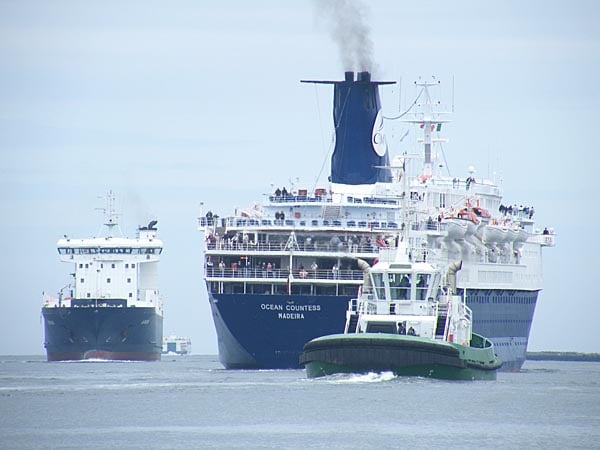
Ocean Countess departing Dublin. Photo: Jehan Ashmore/ShipSNAPS
A newcomer to Irish ports is Cruise & Maritime Voyages Ocean Countess which is making round Ireland itineraries with calls at Cobh on 13 August and 12 September. Incidently the 'Countess' was converted into a troopship for the Falkland Islands conflict in 1982.
Jewel of the Seas (90,090 GT) makes a Cobh call on 7 September and exactly a month later returns, marking the last cruise-call to Cork in 2010 while Fred Olsen's Boudicca will be Dublin's last caller on 20 November.
For further information on other visiting cruiseships, please click links:




























